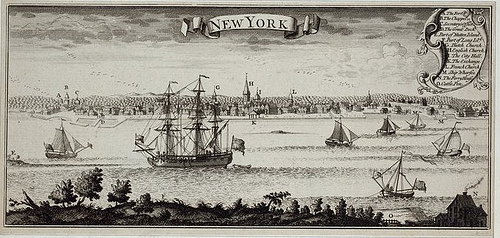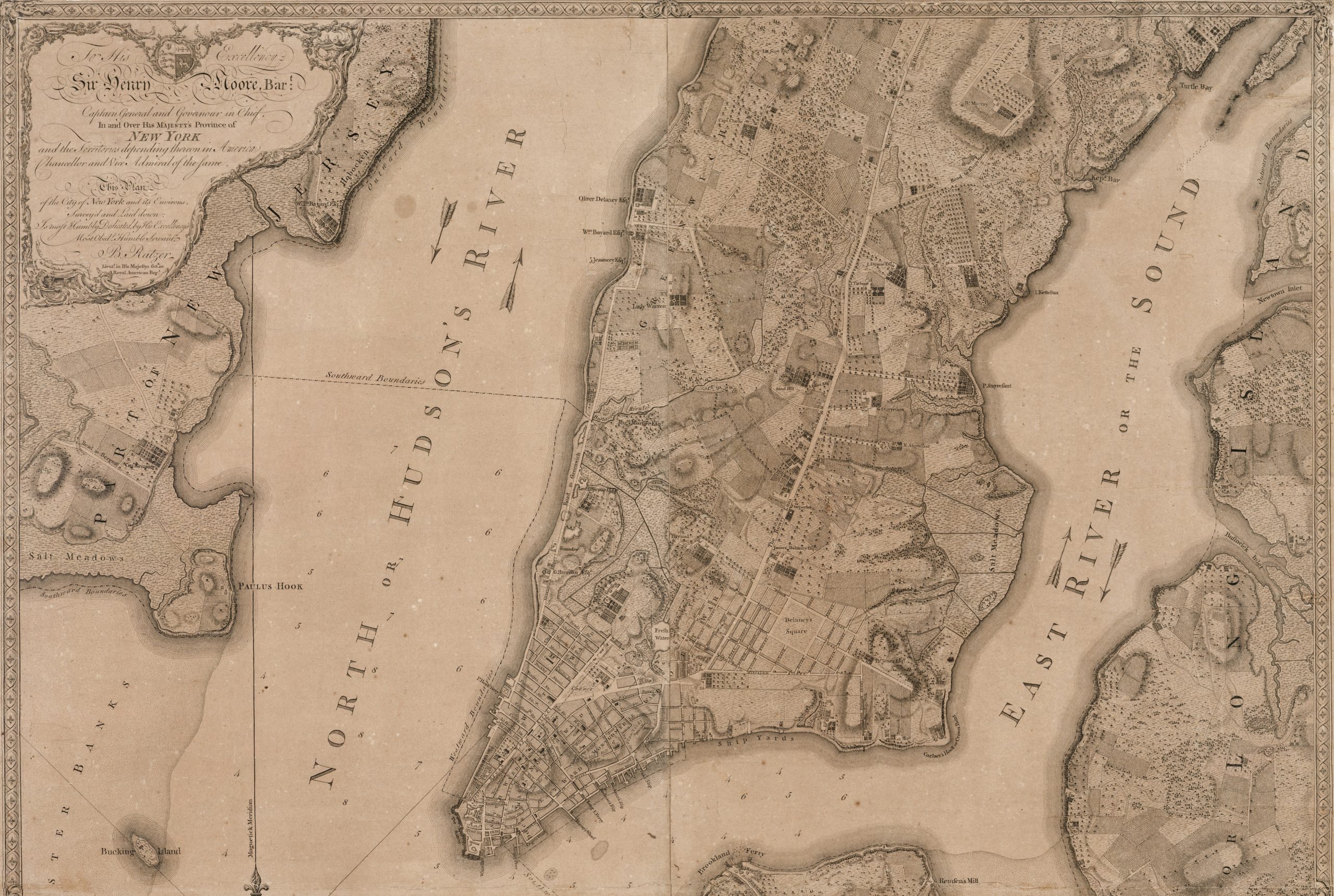69 New York City (1760)

This city is situated upon the point of a small island lying open to the bay on one side and on the others included between the North and East Rivers. And commands a fine prospect of water, the Jerseys, Long Island, Staten Island, and several others which lie scattered in the bay. It contains between two and three thousand houses and sixteen or seventeen thousand inhabitants, is tolerably well built, and has several good houses. The streets are paved and very clean, but in general they are narrow. There are two or three indeed which are spacious and airy, particularly the Broad Way. The houses in this street have most of them a row of trees before them which form an agreeable shade and produce a pretty effect. The whole length of the town is something more than a mile, the breadth of it about half a one. The situation is, I believe, esteemed healthy. But it is subject to one great inconvenience, which is the want of fresh water. So that the inhabitants are obliged to have it brought from springs at some distance out of town. There are several public buildings, though but few that deserve attention. The college when finished will be exceedingly handsome. It is to be built on three sides of a quadrangle fronting Hudson’s or North River and will be the most beautifully situated of any college, I believe, in the world. At present only one wing is finished, which is of stone and consists of twenty-four sets of apartments, each having a large sitting room with a study and bed chamber. They are obliged to make use of some of these apartments for a master’s lodge, library, chapel, hall, etc. But as soon as the whole shall be completed, there will be proper apartments for each of these offices. The name of it is King’s College [now Columbia University].
There are two churches in New York, the old or Trinity Church and the new one, or St. George’s Chapel. Both of them large buildings, the former in the Gothic taste with a spire, the other upon the model of some of the new churches in London. Besides these, there are several other places of religious worship: namely two Low Dutch Calvinist churches, one High Dutch ditto, one French ditto, one German Lutheran church, one Presbyterian meeting-house, one Quakers’ ditto, one Anabaptists ditto, one Moravian ditto, and a Jews synagogue. There is also a very handsome charity-school for sixty poor boys and girls, a good work-house, barracks for a regiment of soldiers, and one of the finest prisons I have ever seen. The court or Stadt house makes no great figure but it is to be repaired and beautified. There is a triangular fort capable of mounting sixty cannon; though at present there are, I believe, only thirty-two. Within this is the governor’s palace and underneath it a battery capable of mounting ninety-four guns and barracks for a company or two of soldiers. Upon one of the islands in the bay is a hospital for sick and wounded seamen and upon another a pest-house. These are the most noted public buildings in and about the city.
Arts and sciences have made no greater progress here than in the other colonies. But as a subscription library has been lately opened and everyone seems zealous to promote learning, it may be hoped that they will hereafter advance faster than they have done hitherto. The college is established upon the same plan as that in the Jerseys, except that this at New York professes the principles of the Church of England. At present the state of it is far from being flourishing, or so good as might be wished. Its fund does not exceed £10,000 currency and there is a great scarcity of professors. A commencement was held nevertheless this summer and seven gentlemen took degrees. There are in it at this time about twenty-five students. The president, Dr. Johnson, is a very worthy and learned man but rather too far advanced in life to have the direction of so young an institution. The late Dr. Bristow left to this college a fine library, of which they are in daily expectation.
The inhabitants of New York in their character very much resemble the Pennsylvanians: more than half of them are Dutch and almost all traders. They are therefore habitually frugal, industrious, and parsimonious. Being however of different nations, different languages, and different religions, it is almost impossible to give them any precise or determinate character. The women are handsome and agreeable, though rather more reserved than the Philadelphian ladies. Their amusements are much the same as in Pennsylvania; viz. balls and sleighing expeditions in the winter and in the summer going in parties upon the water and fishing, or making excursions into the country.
There are several houses pleasantly situated upon East River near New York, where it is common to have turtle-feasts. These happen once or twice in a week. Thirty or forty gentlemen and ladies meet and dine together, drink tea in the afternoon, fish and amuse themselves till evening, and then return home in Italian chaises (the fashionable carriage in this and most parts of America, Virginia excepted, where they make use only of coaches and those commonly drawn by six horses), a gentleman and lady in each chaise. In the way there is a bridge about three miles distant from New York which you always pass over as you return, called the Kissing-Bridge, where it is a part of the etiquette to salute the lady who has put herself under your protection.

The present state of this province is flourishing. It has an extensive trade to many parts of the world, particularly to the West Indies. And has acquired great riches by the commerce which it has carried on under flags of truce to Cape-Francois and Monte-Christo [ports on Hispaniola]. The troops, by having made it the place of their general rendezvous, have also enriched it very much. However it is burdened with taxes and the present public debt amounts to more than £300,000 currency. The taxes are laid upon estates real and personal and there are duties upon Negroes and other importations. The provincial troops are about 2,600 men. The difference of exchange between currency and bills is from 70 to 80 per cent.
Before I left New York I took a ride upon Long Island, the richest spot in the opinion of the New Yorkers, of all America and where they generally have their villas or country houses. It is undeniably beautiful and some parts of it are remarkably fertile but not equal, I think, to the Jerseys. The length of it is something more than 100 miles and the breadth twenty-five. About fifteen or sixteen miles from the west end of it, there opens a large plain between twenty and thirty miles long and four or five broad. There is not a tree growing upon it and it is asserted that there never were any. Strangers are always carried to see this place as a great curiosity and the only one of the kind in North America.
Andrew Burnaby, Travels through the Middle Settlements in North-America, in the Years 1759 and 1760 (London, 1775). 61-67. https://archive.org/details/in.ernet.dli.2015.45494/page/n111/mode/2up
